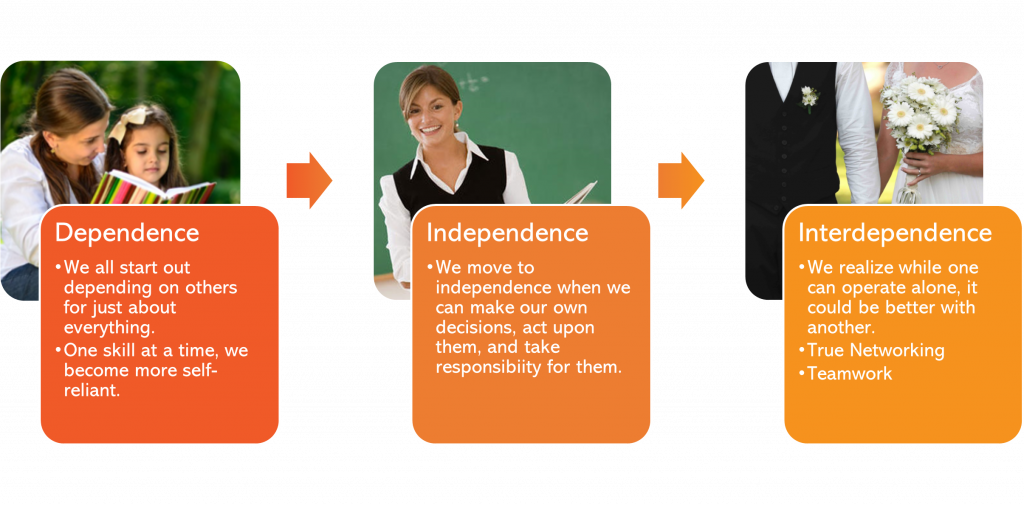
Warum gegenseitige Abhängigkeit für die Teamarbeit entscheidend ist

Von: Diane Isler, DWEN-Mitglied und Gründer von illuminim
Recently, an executive who transitioned to a new role lamented to me, “I cannot get my new team members to work together. Teamwork is one of our stated values, but the organization is so siloed. How can I get my employees to work with each other?” After our discussion, she insisted I share my perspective on relationships more broadly …. so here we are!
What is the underlying issue?
Relationships in business organizations develop like human relationships. Humans develop from complete dependence on others to independence as they mature, with interdependence as the most productive state.

The theory of interdependence posits that relationships have costs and benefits. People in any relationship try to minimize costs and maximize benefits, as you would expect.
In siloed organizations, the organization structure, training, culture, and rewards systems are focused on individuals and individual contribution, keeping the entire organization stuck in an independent state.
So, the real issue in a siloed group is the organization is designed in a way that the cost of interdependence is higher than the reward for working together – for the individuals or teams making the day-to-day decisions on how they will operate.
What is the solution?
Organizations need to be designed with interdependence in mind, if you want the component parts to work well together. If you are part of an existing structure without a magic wand to design from scratch, you can still reduce possible costs and add benefits to move toward interdependence. A few examples:
Reducing costs of interdependence
In an office environment, if people’s workflow is disrupted when they could benefit from a “walk around” to collaborate with others, the cost to individual productivity could be prohibitive. This cost is reduced when desks are organized by business need rather than functional reporting relationships.
For remote employees, an inter-office “chat” application reduces the cost of consulting with teammates.
Collaboration software can also greatly reduce the cost of working together on a project.
Adding benefits for interdependence
Try including team-oriented goals in individual’s annual objectives. You might observe team members actively seeking opportunities to help each other.
Include group problem-solving in team meetings. As the leader, step back from knowing the answer and encourage the team to contribute. Compliment good ideas. You may be surprised how trust and respect grow with this approach.
Structure teams to encourage interdependence. If you have multiple roles with the same responsibilities requiring similar skills, explore giving each one designation at the team “expert” in one of the skills, knowledge sources, or technologies that the team utilizes. The expert’s responsibilities may include covering that topic in team meetings, providing training for the team, onboarding new teammates in their area of expertise, as well as representing the team with vendors or at conferences. If each member has a different expertise, the entire team begins to depend on each other, and the entire team’s depth of knowledge will build more quickly over time.
Team Building Activities
I’ve experienced quite a bit of “team building” in my career. The best I’ve seen follow a format where there is an exchange of ideas related to the work of the team that results in real improvement. Here’s the agenda that I’ve had repeated success with:
- Prework that includes an assessment (of individuals or the team)
- Team Building:
- Review the results of the assessment
- Review of what’s working well and what’s not working
- Break
- Explore how the learnings from assessment can be used to improve team functioning
- Develop SMART objectives or detailed plans
- Optional: fun activity to celebrate
- Follow with ongoing coaching to ensure team makes progress that was planned
Finally, as a leader, are there opportunities for you to increase your interdependence?
Additional Benefits of Interdependence
Employees who feel an integral part of a team (rather than an individual contributor) are more engaged, experience greater job satisfaction, and are less likely to leave their company. For the boomer generation, this greater purpose or team-orientation was considered “nice to have,” but for millennial and centennial employees, this is considered an absolute requirement for their preferred job.
You have a great opportunity to help your organization develop past independence to interdependence, creating team results that are significantly greater than the sum of the individual efforts.


Antworten